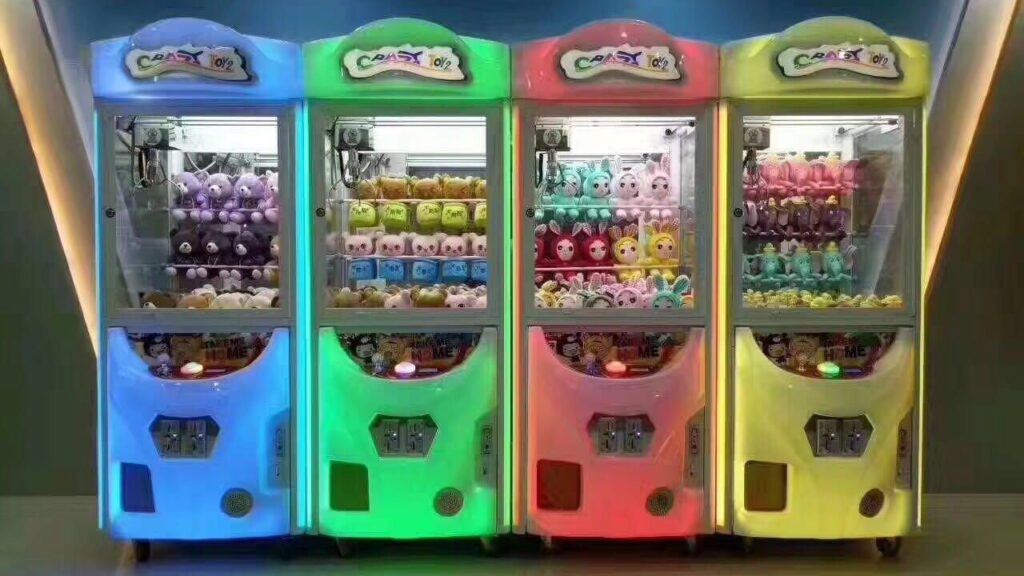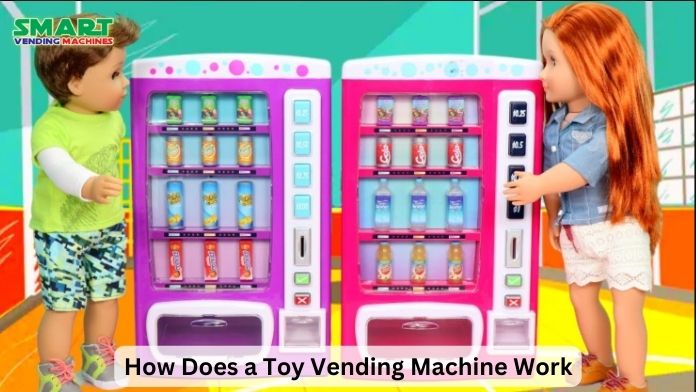Imagine the joy on a child’s face when they see a colorful toy vending machine filled with enticing prizes. These machines have captivated people for decades, creating wonder and amusement.
But have you ever wondered how does a toy vending machine work? Let’s dive into the mechanics and magic behind toy vending machines.
What is a Toy Vending Machine

A toy vending machine, also known as a capsule vending machine or a gumball machine work, is a device that dispenses small toys or trinkets in exchange for a coin or token.
These machines are commonly found in amusement arcades, shopping malls, restaurants, and other entertainment venues. They offer a convenient and interactive way to obtain a surprise toy with the thrill of chance.
How Does a Toy Vending Machine Work
Toy vending machines are fascinating gadgets that offer a world of surprises to children and adults alike.
These machines provide excitement and anticipation as users eagerly try their luck to obtain a small toy or trinket. In this article, we will explore the inner workings of toy vending machines, the different types available, and their popularity among customers and operators.
Types of Toy Vending Machines
Toy vending machines come in various types, each with unique gumball machine mechanisms and features. Let’s explore some of the common types:
Traditional Mechanical Vending Machines
Traditional mechanical vending machines are the classic design most people envision when considering toy vending machines.
They consist of a cylindrical or globe-shaped container filled with toys and a crank or knob that customers turn to release a toy. These machines rely on simple mechanical mechanisms, making them reliable and easy to maintain.
Electronic Vending Machines
Electronic vending machines have gained popularity recently due to their enhanced functionality. These machines often feature digital displays, interactive buttons, and sound effects, creating an engaging user experience.
Some electronic machines even include touchscreens, allowing customers to choose specific toys or themes.
Claw Machines
Claw machines, also known as grabber machines or skill cranes, add an extra challenge to the toy vending experience. These machines have a claw-like mechanism that players control to try and grab a toy or prize within a glass enclosure.
Claw machines require skill and precision, as the claw’s grip strength and movement must be carefully coordinated.
Components of a Toy Vending Machine
Knowing their key components is important to understand how toy vending machines work. Here are the essential parts of a typical toy vending machine:
Cabinet
The cabinet is the outer structure of the vending machine, housing all the internal components. It is usually made of durable materials like metal or plastic to withstand frequent usage and potential vandalism.
Coin Mechanism
The coin mechanism is responsible for accepting and validating coins or tokens inserted by customers. It ensures that only valid currency is accepted, preventing fraudulent or counterfeit coins from being used.
Dispensing Mechanism
The dispensing mechanism is the heart of the vending machine. It holds the toys or trinkets in individual compartments and releases them when a successful transaction occurs.
The mechanism can vary depending on the machine type, ranging from gravity-assisted mechanisms to motorized dispensers.
Display Panel
Customers can view the available toys and make their selections on the display panel. In traditional mechanical machines, the toys are often visible through a transparent globe or window.
Electronic machines may feature digital screens showcasing toy options with accompanying visuals or descriptions.
Prize Storage Area
Behind the scenes, toy vending machines have a storage area to hold toys. This area is accessible to the operator for restocking purposes. Maintaining a sufficient inventory is essential to meeting customer demand.
Toy Vending Machine Work
Understanding the step-by-step process of how a toy vending machine operates can provide insight into its inner workings. Let’s explore the typical workflow:
Inserting Coins
The first step for a customer is to insert the required number of coins or tokens into the vending machine’s coin slot. The machine specifies the amount needed for a successful transaction, often indicated by a sign or instructions.
Coin Validation
Once the coins are inserted, the coin mechanism validates their authenticity and determines if the correct amount has been provided. The mechanism may include various sensors and ratchet gear, such as magnetic or optical sensors, to verify the coins’ legitimacy.
Prize Selection
After accepting the coins, the customer can choose a toy or trinket from the available options. In mechanical machines, this is done by turning a knob or crank, which rotates the internal mechanism and releases a toy from a compartment.
Electronic machines may offer a digital interface with buttons or a touchscreen to facilitate toy selection.
Dispensing the Toy
Once the customer has selected it, the vending machine engages its dispensing mechanism. This mechanism releases the chosen toy from its compartment and delivers it to a retrieval area where the customer can access it.
Prize Retrieval
Finally, the customer can retrieve their toy from the designated retrieval area. Depending on the machine, this area could be a small tray or a door that opens upon successful dispensing. The customer can then enjoy their newly acquired toy or try their luck again for another surprise.
Popular Toys in Vending Machines
Toy vending machines offer prizes that appeal to different age groups and interests. Common toys in these machines include small figurines, keychains, bouncing balls, temporary tattoos, stickers, and mini puzzles.
Operators often update the selection periodically to maintain customer engagement and the novelty of how a toy vending machine works.
Maintenance and Safety Considerations
Regular maintenance and adherence to safety guidelines are essential to ensure toy vending machines’ proper functioning and safety.
Regular Maintenance
Operators should perform routine inspections and clean and lubricate the internal components. This maintenance helps prevent malfunctions, ensure smooth operation, and prolong the machine’s lifespan.
Safety Features
Toy vending machines incorporate safety features to protect users, especially children. These features may include rounded edges, tamper-resistant locks, and age-appropriate designs. Operators must adhere to safety regulations and guidelines to prevent accidents or injuries.
Benefits of Toy Vending Machines
Toy vending machines offer several advantages for both customers and operators. Let’s explore some of these benefits:
Entertainment and Fun
Toy vending machines provide entertainment and excitement for customers, especially children. They offer a sense of anticipation and surprise, enhancing the overall experience of obtaining a toy or trinket.
Revenue Generation
Toy vending machines can be a profitable business venture for operators. These machines can generate consistent revenue with a low initial investment and minimal overhead costs.
Additionally, their automated operation ensures a streamlined process. Moreover, the convenience they offer attracts customers, resulting in increased sales.
Furthermore, this business model’s scalability allows for expansion into new locations. In conclusion, these machines are a profitable investment.
Engaging for Children
Toy vending machines can help children develop fine motor skills and hand-eye coordination. They also encourage decision-making and the concept of chance, as users must select a toy without knowing its exact outcome.
Challenges of Toy Vending Machines
While toy vending machines have numerous benefits, they also come with a few challenges that operators may encounter:
Machine Malfunctions
Like any mechanical or electronic device, toy vending machines can experience malfunctions over time.
These issues include jammed dispensing mechanisms, coin validation errors, or electrical problems. However, regular maintenance and prompt repairs can mitigate these challenges.
Additionally, investing in high-quality components and materials and providing user instructions can minimize malfunctions and ensure customer satisfaction.
Coin Jamming
Coin jamming occurs when coins get stuck in the mechanism, preventing the vending machine from accepting new transactions. Operators must promptly address coin jams to ensure uninterrupted operation and customer satisfaction.
Inventory Management
Managing inventory in toy vending machines can be a balancing act. First, operators must monitor stock levels carefully. They also need to restock popular items promptly to meet customers’ demands.
Furthermore, it is essential to ensure a variety of toys are available to cater to different preferences. Additionally, efficient inventory management is crucial in maximizing revenue and customer satisfaction.
Future Trends in Toy Vending Machines
As technology evolves, toy vending machines will likely incorporate innovative features. Furthermore, these machines may include interactive displays with augmented reality elements.
Additionally, they could integrate mobile app functionality for remote control and monitoring.
Moreover, personalized toy selection based on customer preferences could be another notable feature. In response to changing consumer expectations, the industry will likely strive to enhance the user experience and adapt accordingly.
The Outer Structure
Toy vending machines typically have a sturdy metal or plastic body to withstand frequent usage and secure valuable contents.
Additionally, they come in various shapes, sizes, and designs. Moreover, they are often adorned with vibrant colors and eye-catching graphics to attract attention.
The Inner Mechanism
Behind the appealing exterior lies a complex series of mechanisms that work harmoniously to dispense toys. Firstly, at the heart of the machine is a central dispensing unit.
Additionally, this unit holds a supply of toy capsules or gumballs.
Moreover, these capsules are pre-filled with various toys, figurines, or novelty items. Therefore, the combination of the exterior, central dispensing unit, and pre-filled capsules creates a captivating toy vending machine.
Conclusion
Toy vending machines offer a delightful and interactive way to acquire quarter small toys and trinkets. Understanding their inner workings, components, and operational processes can deepen our appreciation for these fascinating contraptions.
Every step in the process adds joy and anticipation, from the insertion of coins to dispensing prizes. So, the next time you encounter a toy vending machine, you can marvel at the intricate mechanics behind its magical surprises.
FAQ
Can I Choose the Toy I Want From a Vending Machine?
In traditional toy vending machines, the toy you receive is determined by chance. However, some modern electronic machines offer a selection interface where you can choose specific toys or themes.
How Much Does it Cost to Operate a Toy Vending Machine?
The cost of operating a toy vending machine varies depending on location, machine type, and inventory expenses. Operators must also consider maintenance, restocking, and acquiring new inventory expenses.
Are Toy Vending Machines Profitable?
If managed effectively, toy vending machines can be a profitable business venture. Furthermore, operators must consider several factors, including location, foot traffic, toy selection, and maintenance, to maximize their revenue potential.
Are There Any Age Restrictions for Using Toy Vending Machines?
Toy vending machines are generally accessible to people of all ages. However, adults should supervise young children to ensure a safe and enjoyable experience.
Can I Customize the Toys in a Vending Machine?
While customization options may vary depending on the operator and machine type, some toy vending machines can customize the toys or trinkets inside. This allows for personalized offerings and can cater to specific preferences or themes.

